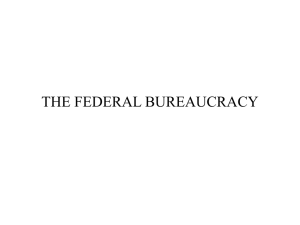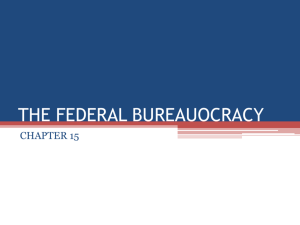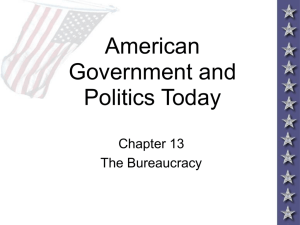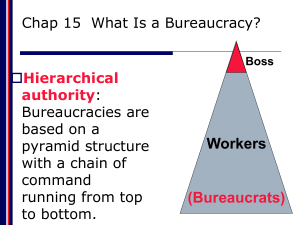Chapter_11
advertisement
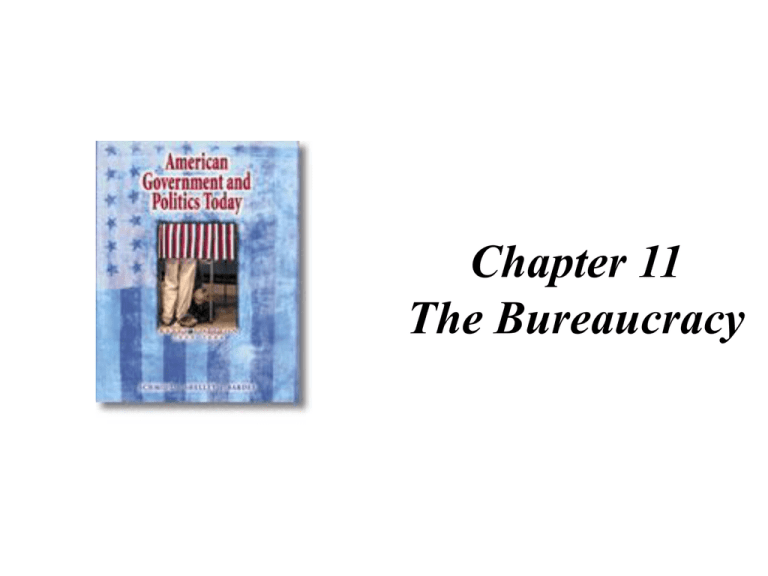
Chapter 11 The Bureaucracy What is a bureaucracy? • A large organization that is structured hierarchically to carry out specific functions (”Fourth branch of Govt.”) • Private bureaucracies exist within organizations like corporations. They have a single set of leaders • Excluding the military, there are 2.8 million govt. employees. In addition, there are subcontractors and consultants. If all govt. employees are counted then it is more than 15 percent of all civilian employment. The cost of the bureaucracy is about 40 percent of the U.S. Gross National Product (GNP) • Public bureaucracies exist within organizations like governments • Typically have multiple sets of leaders (Congress, President, etc.) • Serve citizen instead of stockholders Theories of Bureaucracy • Weberian Model: Complex life and demands placed on govt. by society make bureaucracies inevitable. They have a hierarchy. Top-down management. Detailed rules and regs. Bureaucrats are specialists. Merit system. Apolitical in nature. • Acquisitive Model: Top-level bureaucrats will try to expand or avoid reductions in their budgets. They try to “sell” their products to Congress and the public. • Monopolistic Model: No competition. Not penalized for chronic inefficiency • Garbage Can Model: Bureaucrats do not act in any purposeful or coherent manner, but bumble along searching for solutions to problems. Little formal organization. Trial and error. The Organization of the Federal Government There are four types of bureaucratic structures: • Cabinet Departments: Line organizations answerable only to the president. Created by Congress. They consist of top political appointees and then regular employees who may resist change • Independent Executive Agencies: They are not in a department, but answerable to the president who appoints their chiefs. • Independent Regulatory Agencies: Responsible for a specific type of public policy. They make and implement rules and regs. to protect the public interest. Independent of all branches of govt., but they combine some aspects of all branches. They were created for technical reasons that Congress could not perform. Appointed by the president but do not report to the president. Members of these agencies cannot all belong to the same political party. Some say they have been captured by the parties they are supposed to regulate. • Government Corporations: Has a board of directors and managers, but no shareholders. If it makes a profit, it gets to keep the profit. No dividends here. Staffing the Bureaucracy • Political appointees: President’s choice. Experience, education, characteristics, politics, intelligence. The aristocracy of the federal govt. Usually serve for brief times, however (2 years). Their employees may not feel compelled to carry out their boss’s directives. • Civil service: The Spoils System, Civil Service Reform Act of 1883 (Pendleton Act) created a Merit System based on examinations. Created also the Civil Service Commission History of the Federal Civil Service • Officials cannot discharge a worker for supporting a political party. Violation of the First Amendment • The Hatch Act of 1939: Civil Servants cannot take an active role in the political management of a campaign. Cannot use federal govt. to influence nominations and elections. Cannot use bureaucratic rank to pressure employees to make political contributions • The Civil Service Reform Act of 1978: Abolished the Civil Service Commission. Created the OPM Office of Personnel Management and MSPB Merit Systems Protection Board. Modern Attempts at Bureaucratic Reform • Sunshine Laws: 1976 Government in the Sunshine Act: Required that all multiheaded federal agencies hold meetings regularly in public session except when court proceedings and personnel matters are discussed. • Sunset Laws: When govt. programs are on a definite schedule for congressional consideration. If Congress doesn’t fund it, it dies. • Contracting Out: Along the lines of bureaucratic reform. Private sector does the job more efficiently than the bureaucracy. E.g. prisons, vouchers. • Incentives: Performance-based bonuses. Mostly at the state level. Federal level: The Government Performance and Results Act of 1997. All agencies must describe their goals and how they are going to achieve them. (broadly and narrowly crafted) • Helping Whistle Blowers: Someone who blows the whistle on gross govt. inefficiency. Prohibits reprisals. MSPB helps. Toll Free hotlines. Whistle Blower Protection Act of 1989 created the Office of Special Counsel (OSC) to investigate demotions, firings, sanctions for reporting waste. False Claims Act of 1986 allows for monetary rewards if the govt. prosecutes those defrauding the govt. Bureaucrats as Politicians and Policymakers • • • • • • Enabling Legislation: Where Congress delegates power to an agency. “It generally specifies the name, purpose, composition, functions, and powers of the agency” Agencies should implement the laws that Congress passes, but most of the time those laws are vague. Discretion is given to agencies and their administrators, but it is not accidental. Congress cannot keep up with the expertise that may be needed in public policy. Rule making capabilities. 60-day waiting period. Negotiated Rulemaking: Putting all the direct players together and discussing the proposed rules (rule drafting) before hand…to avoid lawsuits. Negotiated Rulemaking Act of 1990. Iron Triangles: A three-way alliance among legislators, bureaucrats, and interest groups. Issue Networks: A group of individuals or organizations that support a particular policy position on some issue. They have replaced “Iron Triangles” due to the complexity of policymaking today. Too many interest groups, size of the bureaucracy, increased number of subcommittees, agencies that are controlled by more than one legislative group. They usually include: legislators, scholars, bureaucrats, experts, interest groups, media, etc. Congressional Control of the Bureaucracy • Congress usually specifies the bureaucracies “enabling legislation” which is its power to operate within a certain boundary. • Authorizing Funds and Appropriating Funds: “Power of the Purse” • Congressional Investigations, hearings and review: The use of the General Accounting Office (GAO) and the Congressional Budget Office (CBO) to conduct studies. • Congressional Review Act of 1996: To express congressional disapproval of particular agency actions. It has been rarely used, however. Hot Links to Selected Internet Resources: • http://www.wadsworth.com/cgiwadsworth/course_products_wp.pl?fid=M2&discipline_number=20& product_isbn_issn=0534592651 • http://www.wadsworth.com/politicalscience • http://www.fedworld.gov • http://www.infoctr.edu/fwl • http://www.access.gpo.gov/su_docs/index.html


